How to Upload 3d Model to Google Earth
Previewing a SketchUp model in Google Globe is great mode to see how your model looks in the context of its surroundings.
You commencement the process in SketchUp, where you optimize the model for viewing in Google World. Because Google Earth and SketchUp models can both utilise a lot of your graphics card's processing power, your model needs to exist as light as possible.
When your model is ready, you can preview your model in Google Earth by easily exporting to KMZ from SketchUp and and then opening your KMZ file in Google World.
Of course, all this assumes y'all have Google Earth installed on your computer. If not, Google Earth is free, and y'all can download the software at www.google.com/earth.
In the sections that follow, you notice help with optimizing your model, previewing your geo-located model in Google Earth, and finding additional online learning resources.
Tip: For an in-depth look at site-modeling in SketchUp, check out the following video. The video walks you through an architectural workflow for creating a site model past combining SketchUp, Google Earth, and Google Maps.
Table of Contents
- Optimizing a model for display in Google World
- Previewing a model in Google Earth
- Placing models in the ocean
- Saving a model in Google Globe
- Finding help with Google Globe
Optimizing a model for display in Google World
When y'all create a 3D model that yous want to display in Google Earth, you tin create your model in SketchUp so that your model looks its best in Google Globe. This section explains the SketchUp modeling techniques that work best with Google Earth.
Geolocate your model
To geolocate your model in SketchUp Pro 2017, import terrain using the Add Location tool. When you geolocate your model with the Add together Location tool, you lot tin can import terrain that enables you to create your model based on the site where you programme to build it (or only display information technology in Google Earth). Wherever yous identify your model on imported terrain in SketchUp determines the location of your model when yous preview it in Google Earth. See Modeling Terrain and Other Rounded Shapes for details nearly importing and sculpting terrain as well as tips for modeling terrain that y'all desire to brandish in Google Earth.
You can add a location manually in any version of SketchUp. Select Window > Model Info, select the Geo-location choice in the sidebar on the left, click Fix Manual Location, and enter a latitude and longitude in the dialog box that appears. When y'all geolocate your model, yous ensure your model appears in the correct location in Google Earth.
If you don't geolocate your model, your model appears in Google Earth at a default location.
Note: Your default location depends on the language associated with SketchUp. For example, if you downloaded the American English version of SketchUp, SketchUp's default location is Bedrock, Colorado. Other default locations include London, Paris, Berlin, Rome, Tokyo, Barcelona, Taipei, Brasilia, Seoul, Beijing, Moscow, and Amsterdam.
Create a precise model
When you display your model in Google Earth, your model dimensions demand to be accurate and so that your model's scale is proportional to the surrounding mural or buildings in Google Earth.
Measuring Angles and Distances to Model Precisely explains how to create a model with precise dimensions. If you create a model with the Friction match Photo feature, you lot tin can scale the model subsequently you're done creating it.
Minimize the edges and faces
Tip: The key to optimizing a SketchUp model for Google Earth is to keep the model complication equally light every bit possible.
For case, the post-obit figure shows a model of the Eiffel tower optimized for display in Google Earth. Without textures projected onto the model (as explained in a moment), y'all can see how minimal the underlying geometry can be, even when you're modeling a complex structure.

Every bit yous create a model with minimal geometry, recollect that you can reduce the number of sides in a circle or an arc.
Make sure fronts of faces are facing outward
Remember that SketchUp faces have a forepart and back. If the back side of a face points outward, the confront appears black in Google Earth, no affair what material is applied to the back side of the face.
To check that the face fronts point outward in SketchUp, select View > Face Mode > Monochrome to see whether the dorsum sides of a any faces indicate outward. By default, the confront fronts are white and face backs are night grey. To reverse a face, context-click information technology and select Reverse Faces.
In the post-obit figure, you run across a basic model with materials (left) and in monochrome (right); the left, side face needs to be reversed.
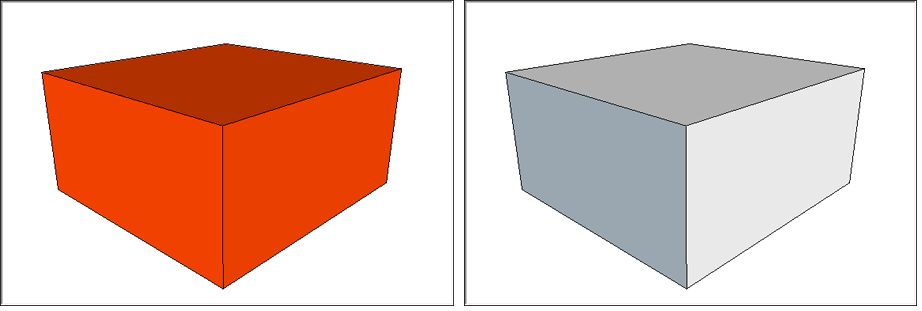
Tip: Sometimes, it'southward hard to determine whether a confront is truly facing outward or only shaded to show perspective. If you're having trouble, orbit so you have a straight-ahead view of the confront. Or, in the Styles browser, y'all tin utilise the Confront Settings to edit the default dorsum confront color and then that the backs of faces stand out more than they practise in the default greyness.
Convey model details by projecting paradigm textures onto your model
In a model that's optimized for viewing in Google Earth, the geometry itself conveys picayune detail virtually the building. Instead, yous use photos applied to each face up to show the detail.
In SketchUp, applying a photo to a confront is called projecting a texture. You tin can project a texture by importing a photo equally a texture or projecting textures after you use the Match Photo feature.
You can use Google imagery, digital photos, or graphics you create as photo textures in SketchUp. For instance:
- If you're modeling an existing building, you might be able to import images from Google or take your photos with a digital camera. (The article on using the Match Photo characteristic includes tips on taking photos for 3D modeling.)
- If you lot're modeling a edifice program, you tin create a building image in a graphics editor and consign it in ane of the image formats that SketchUp photo textures support, such as
.png. Or employ custom photograph textures to your model equally materials, and projection the textures before viewing your model in Google Earth. For details, come across Applying Colors, Photos, Materials, and Textures.
Tip: Considering your overall goal in optimizing your model for Google Earth is the smallest file size, brand sure your images are optimized for the Spider web. Both .png and .jpg files tin can exist compressed to lower the file size. If you're using images taken with a digital photographic camera, be sure to optimize the images for the web in your image editor before importing the images into SketchUp.
Texture your model with images that support transparency
If y'all need to be able to wait through office of your edifice, create transparent areas in the images that you lot use to texture your model. Y'all may need to convert your images to a file format that supports transparency, such every bit .png, then create the transparent areas in an image editor.
In the following figure, you come across the Eiffel tower model with photo textures that incorporate areas of transparency. On the left, you lot see the model in Google Globe, and on the right, yous see the same model in SketchUp. Notice that the model looks realistic and that you can await through the structure, merely as you lot can with the real tower.

Previewing a model in Google World
With many projects, the training is the hardest part. Previewing a model in Google World is no exception. When your model is prepare to preview, all you lot demand to do is export your SketchUp model equally a Google World KMZ file. Simply open the KMZ with Google Earth and viola!
For case, the post-obit figure shows a model of a garden shed placed on imported terrain.
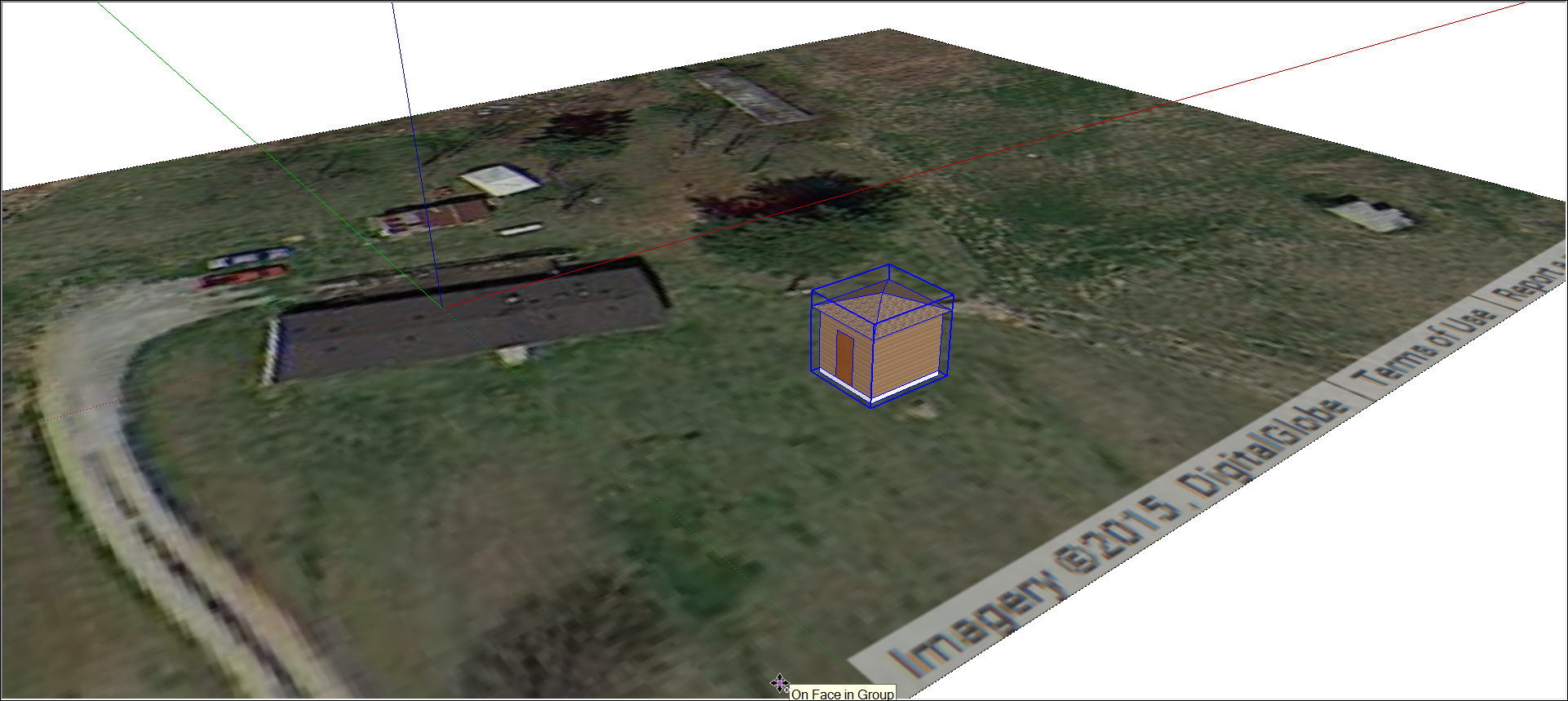
Later you tell SketchUp that you want to preview the model in Google Earth, Google World loads your model and zooms to show in the location you indicated, equally shown in the following effigy.
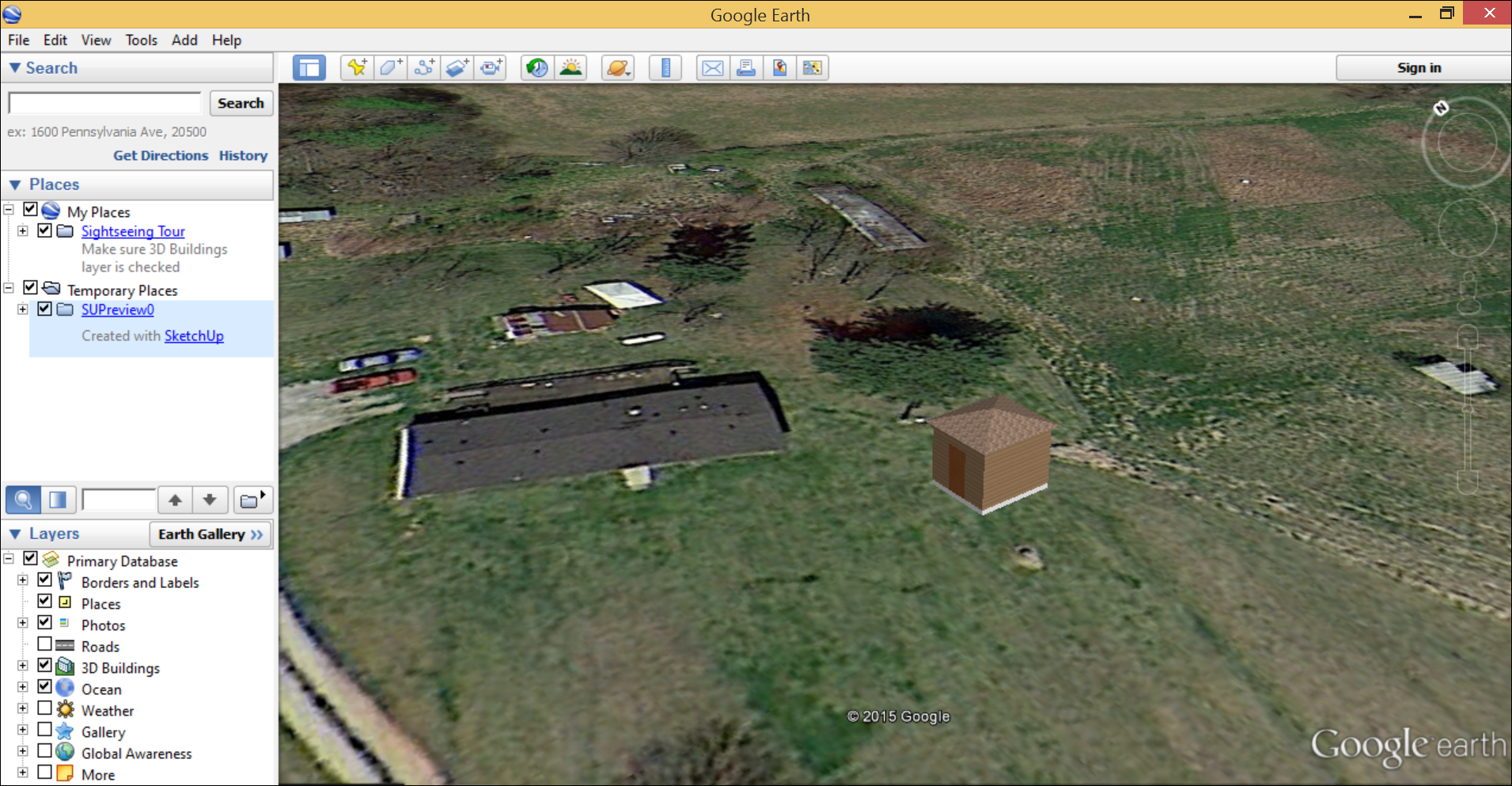
Annotation that sometimes Google Earth imagery is a footling older than what's in Google Maps' aerial or Street View photography. Also, in flat areas or areas with mostly rectilinear buildings, you can see your model in the context of the surrounding surface area more easily than yous can in a neighborhood with lots of mature trees.
Within Google World, yous can use Google World's navigation tools to move effectually the area and meet how your model looks on its intended site.
Placing models in the ocean
Google World has an Ocean layer, and y'all can preview models in the body of water by completing a few extra steps.
Beginning, in SketchUp, select Window > Extension Warehouse, and in the Extension Warehouse window that opens, search for the Ocean Modeling extension. Subsequently you select the extension to open up its folio, you lot can click an Install button the upper correct.
Afterward the Bounding main Modeling extension installed, you tin can locate your model in the bounding main and preview it in Google World. The post-obit effigy shows the garden shed floating the Pacific Ocean, off the coast of Los Angeles, California.
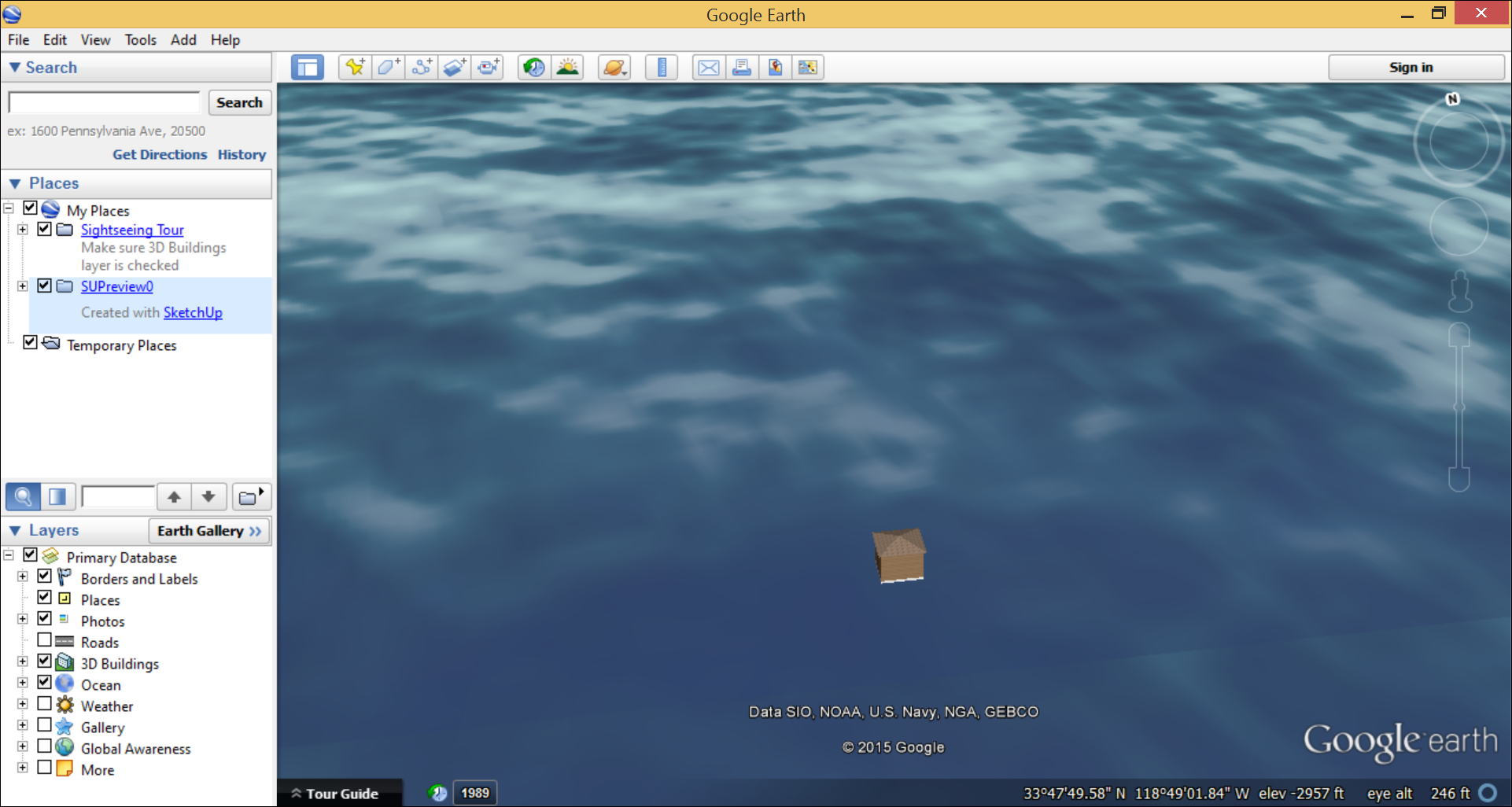
Saving a model in Google Earth
When you preview a model in Google Earth, the model is loaded into Temporary Places. If you want to save your model in Google Earth, context-click the temporary model name in the Temporary Places folder and select Save to My Places. The model and so moves from the Temporary Places folder to the My Places folder, as shown in the following figure.
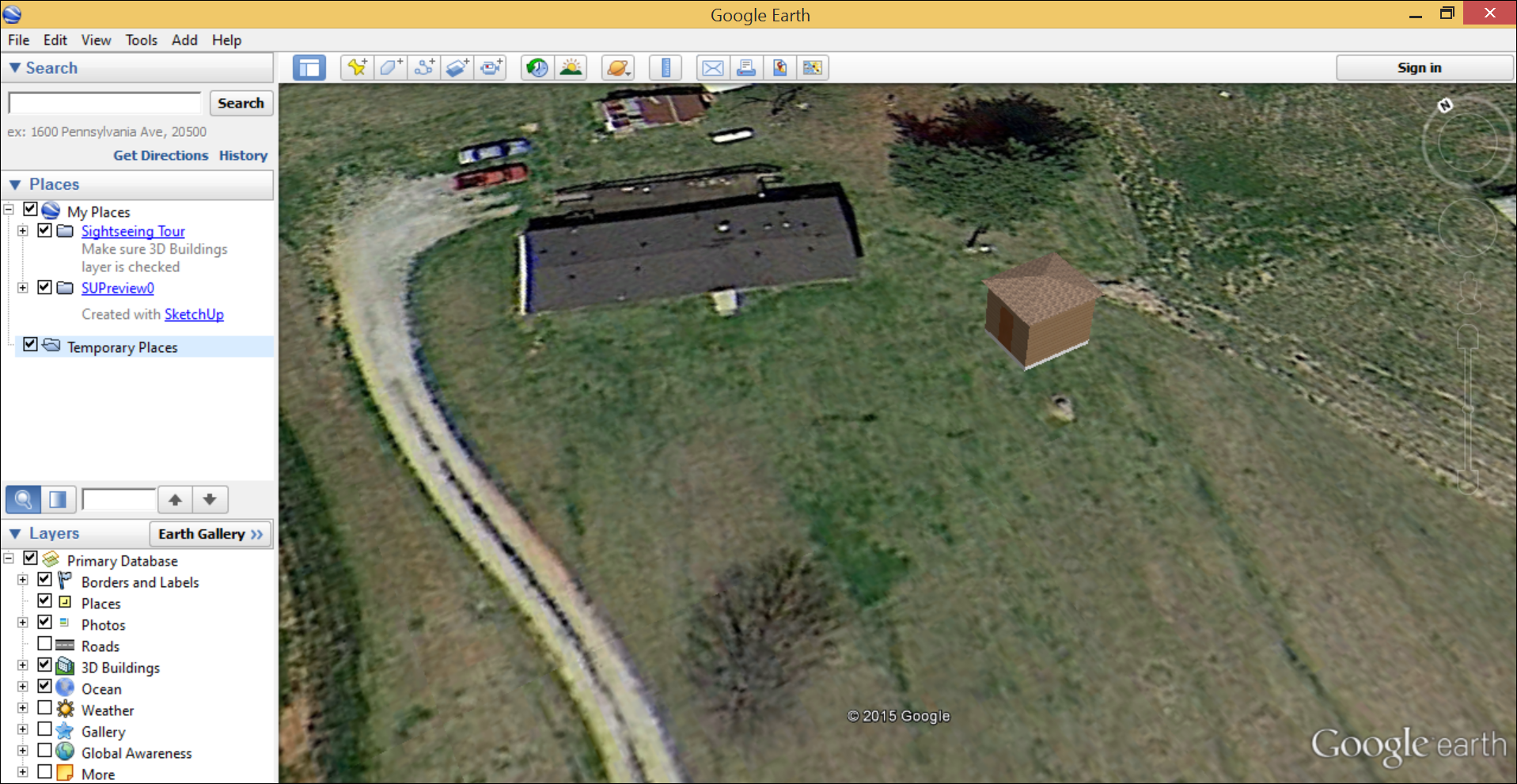
Afterwards your model is saved in Google Earth, you can open Google Earth directly, select the model, and fly to it. You don't need to use the preview characteristic in SketchUp.
Tip: Past default, your model is named SUPreview0 in Google World. To requite your model a more descriptive name, context-click the model proper name in Google Globe'south Places pane and select Rename. If you need to delete a model from Google World, context-click its name in the Places pane and select Delete.
Finding help with Google Earth
Although SketchUp includes tools for previewing your model in Google Earth, Trimble doesn't offer full Google Globe support.
You discover several Google Earth tutorials for beginning and advanced users on Google World'south Larn page. Yous can too take a full tour of the Google Earth interface.
On Google Earth's Connect page, you lot find links to the Google World community, including its user forum, and newsletter.
Source: https://help.sketchup.com/en/sketchup/viewing-your-model-google-earth
0 Response to "How to Upload 3d Model to Google Earth"
Post a Comment